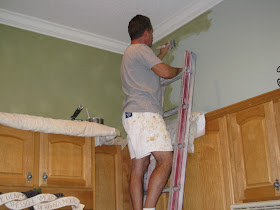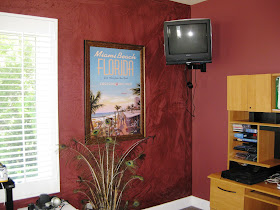
Here is an easy way to paint stripes, eight inch stripes with alternating colors and slightly distressed. No tape will be used to paint the stripes. This project could be used for an accent wall or the entire room.
First prep your area and apply blue tape to the base boards or as needed. Measure the wall where the stripes will be painted, divide the width of the stripes you would like to have into the total length of the wall. Example: 192 inches ( 16 ft ) divided by 8 inches = 24 stripes. If you end up with a odd number divide that number into your total stripes. So in this case your stripes could be 8 1/8 inches each.
Next, make a small mark to the top and bottom of the wall where each stripe will be, move from one
end of the wall to the other end. Mark every other stripe which will be the different color, I use a small piece of blue tape.
Take a 4 ft. level and place it on the mark of your stripe. Use a 2 1/2 in. paint brush with the first paint color ( no glaze ) and brush up against the level running vertical on the wall. Continue down the wall with the level ensuring it is plum.

Your creating a guide line for your stripe, keep from overloading paint on your brush.
Wipe the excess paint from the level and move to the other side of the stripe. This process will continue for every other stripe till you get to end of the wall.
Fill in each stripe with your first color ( light beige ), the stripes shown were painted over a golden tan base, let some of the base show threw.
Now apply the second color ( yellow ) to the next group of stripes using a dry
brush working with vertical strokes. The wall should look like its
almost completed. These stripes can be cut in, the level does not have to be used.

Once all the yellow stripes have been painted add yellow
brush marks to the lighter stripes.
Add the lighter color to the yellow
stripes. Finally, add an off white with a brush to each
stripe randomly to produce high lights.

Note: There are four colors used to produce this technique. Choose a light, med and darker color. Flat paint was used for this project.
Base: Benjamin Moore # HC-9
Light stripes - BM # 226
Yellow Stripes- BM # 270
Highlight - mix 1 part HC- 9 with 3 parts white
The fourth color is used to high light. The base coat the darker color, the light stripe a beige tone and the other stripe a yellow.











.JPG)





















